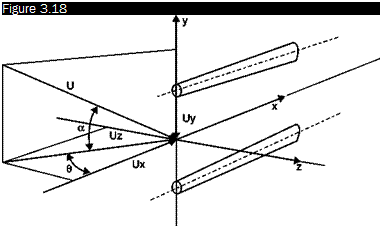Directional sensitivity in the plane wire/supports
If the stream direction is not normal to the sensor, the collected data are biased compared to those provided by the calibration. If the velocity vector lies in the wire/support plane, i. e. в = 0 in Figure 3.18, and if the angle from the normal to the wire is small, the component normal to the wire can be considered as the effective speed on the sensor
Ue[[ = Ucos а (3.16)
 |
Decomposition of the velocity vector on the axes of the probe
For greater angles, the velocity component parallel to the sensor contributes, albeit with minor effectiveness, to cooling and that is why the more accurate Equation (3.17) must be used
Uf = U1 (cos2 a + ksen2a) (3.17)
The value of k2 (yaw factor) depends on the sensor type and on the length/diameter ratio of the wire and should be evaluated for each probe by varying the angle a in a known stream; alternatively, the average values provided by the manufacturers and listed below can be used:
|
k2 |
|
|
Miniature probe |
0.04 |
|
Gold-plated probe |
0.0225 |
|
Fiber probe |
0.04 |
If the probe is inclined with a known angle with respect to the direction of speed, the true value of the speed can be found from that measured by the probe by using, depending on the required accuracy, Equation (3.16) or Equation (3.17).
If the direction of velocity is unknown, it is not possible by Equation (3.16) or Equation (3.17) to obtain simultaneously the value and the
direction of speed (two unknowns from a single equation). It is necessary to use two sensors in two directions to obtain two independent measurements from which both unknowns can be calculated.











